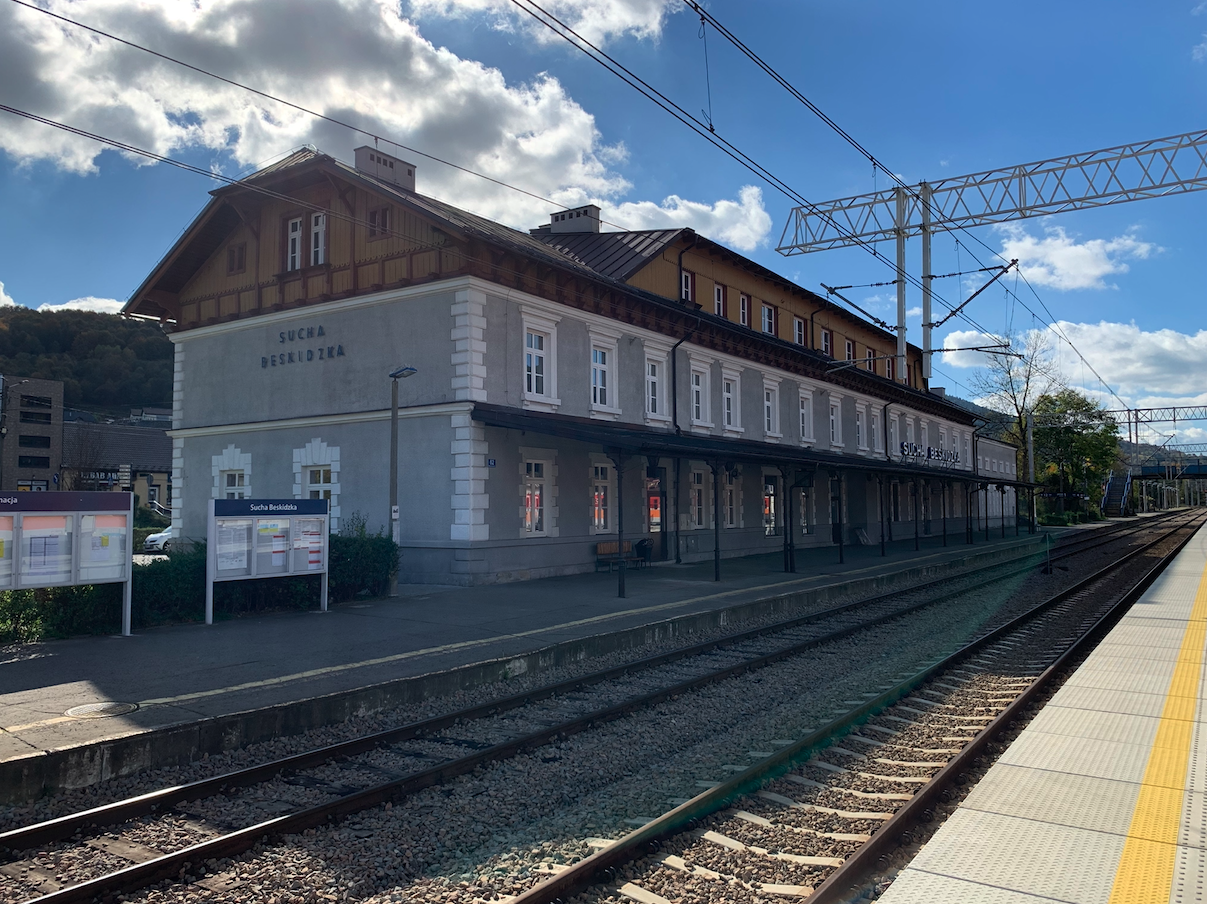Sucha Beskidzka. 2022-10-17
Sucha Beskidzka Railway Station.
Geographic coordinates: 49.740N 19.581E. Elevation 343 m.
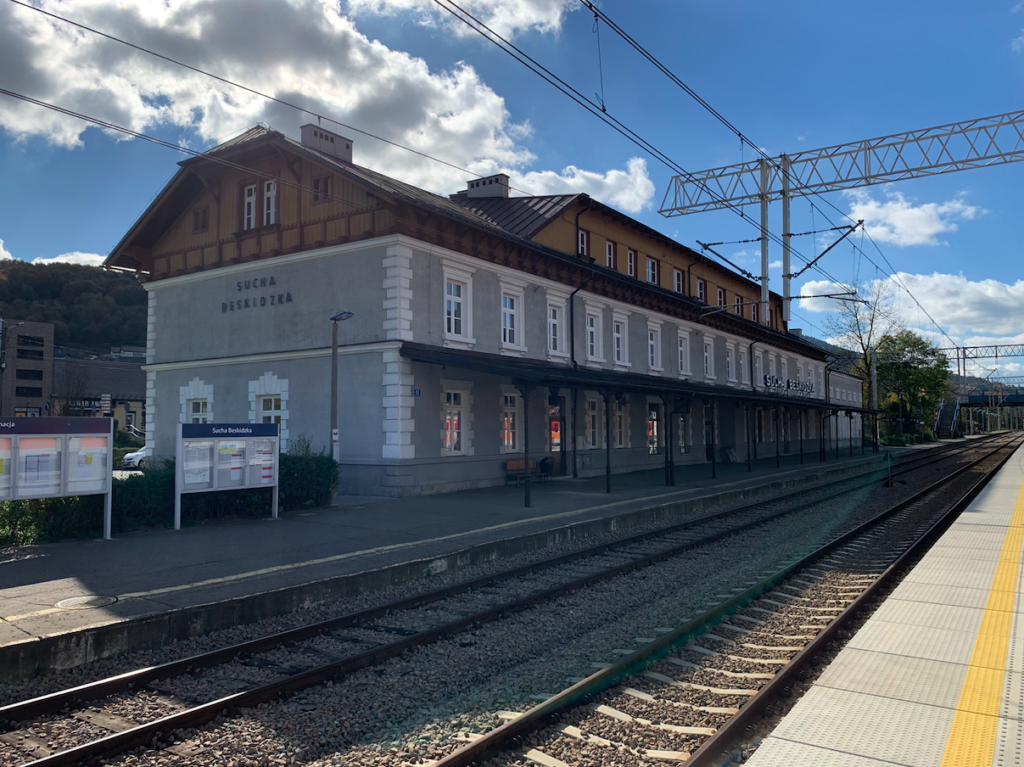
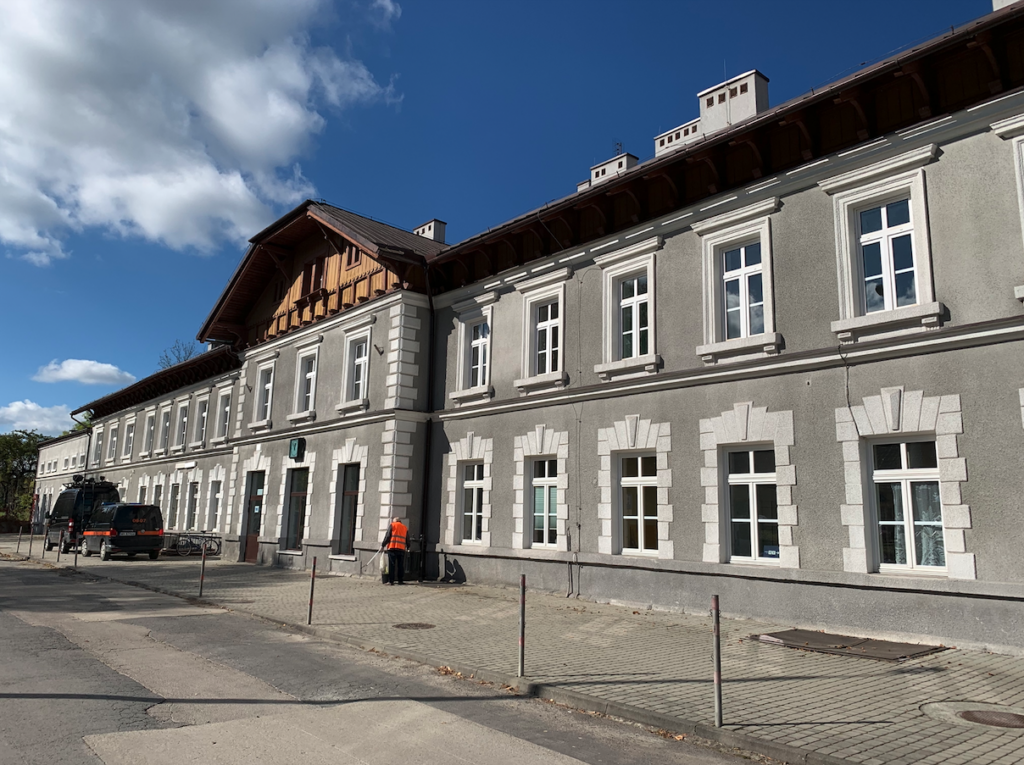
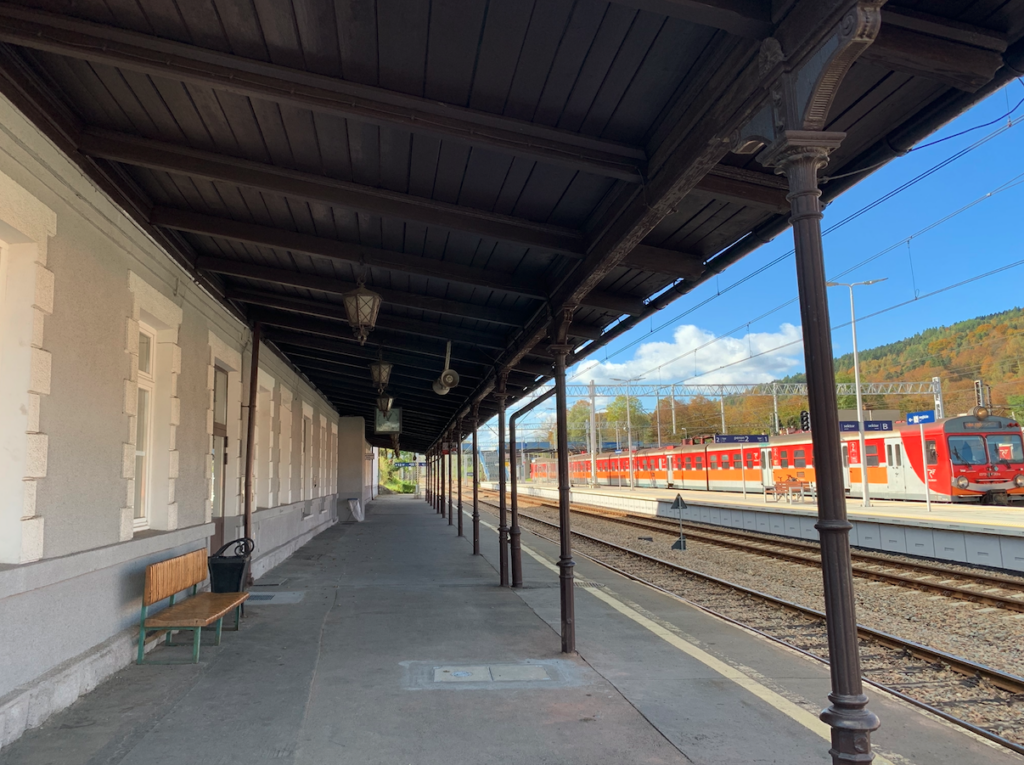
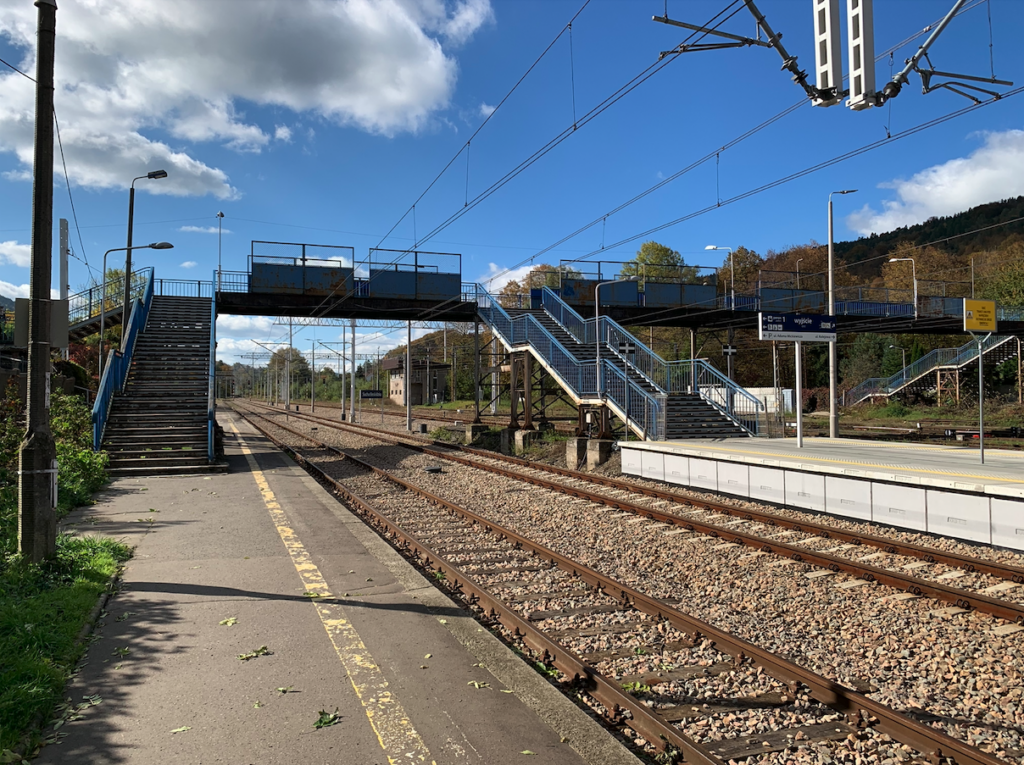
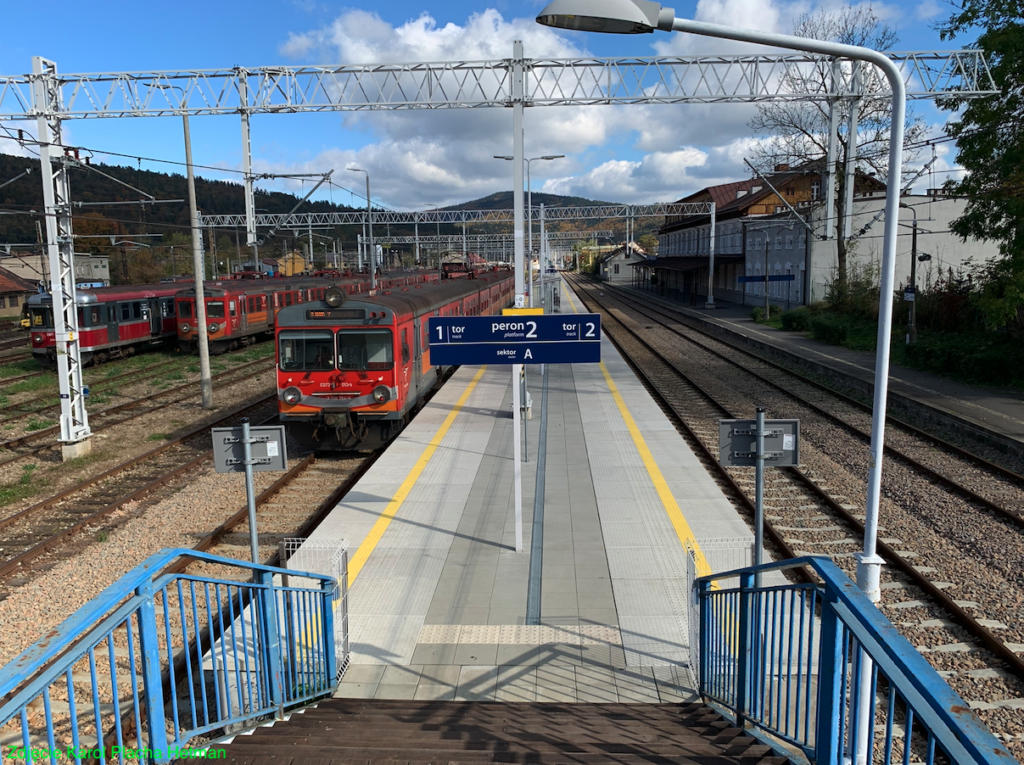

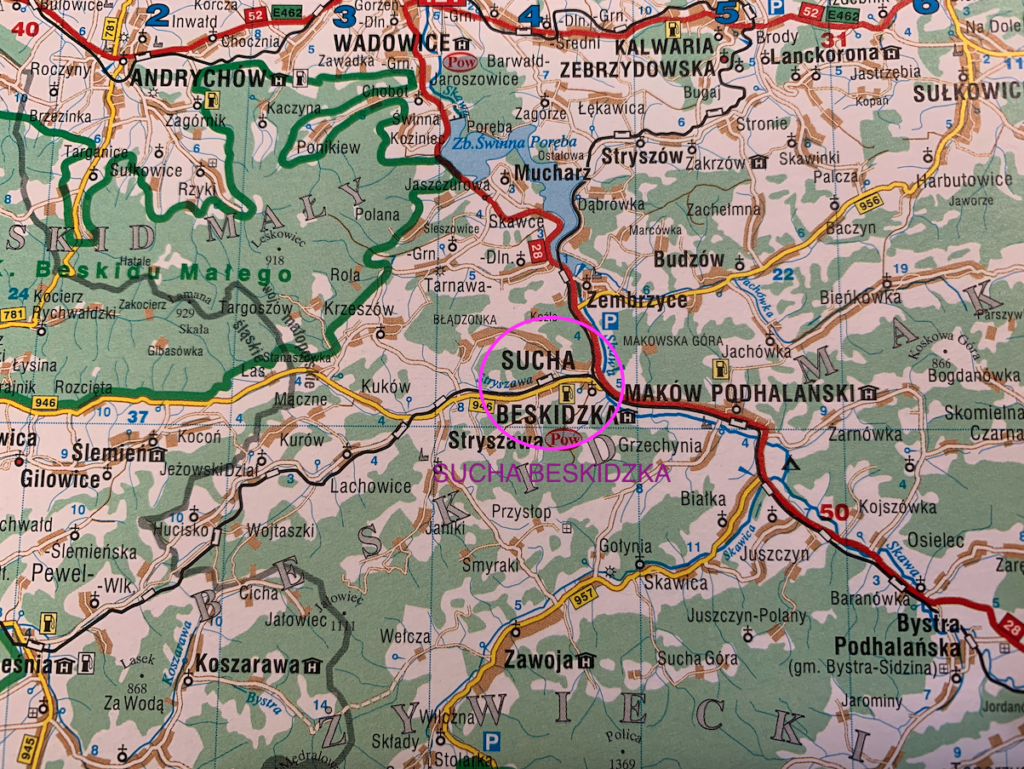
The city of Sucha Beskidzka.
Sucha Beskidzka is a city in Poland, located in the south in the Beskid Makowski Mountains. Lesser Poland Voivodeship, Suski County and is the seat of the starosty. The settlement developed on the Stryszawka River, which here flows into the Skawa River. The settlement was founded in 1405, and received city rights in 1896, i.e. after the railway line was already brought here. The city lies at an altitude of 350 m above sea level. Until November 27, 1965, the city was called Sucha. In 2019, the city of Sucha Beskidzka had an area of 27.65 km2 and was inhabited by 9,088 inhabitants.
History of Sucha Beskidzka.
The settlement was established in the Duchy of Oświęcim and was associated with the action of settling these areas. The Strzał family received the right to settle. In 1564, the Duchy of Oświęcim was incorporated into the Crown of the Kingdom of Poland. In 1772, as a result of the partitions of Poland, the Makowski Beskids were incorporated into Austria-Hungary. In the period 1556 – 1939, Sucha was part of the so-called Suski state and was private property. That is why in Sucha Beskidzka there is a princely castle, the main body of which is modeled on Wawel. For many centuries it was an impressive magnate residence. The residence contained one of the largest library collections in Europe, which, however, were robbed during World War II. The castle is worth visiting. In Sucha there were: a glassworks, a water mill, a brewery, a hop drying room, a distillery, an iron and copper forge, sawmills and other workshops. As a market settlement, Sucha had the privilege of organizing fairs. Sucha was not spared fires, epidemics and famines.
Road transport. Due to the mountainous location of Sucha Beskidzka, few roads run through the city. The most important is National Road No. 28 Zator – Medyka. Provincial Road No. 946 Sucha Beskidzka – Żywiec starts in Sucha Beskidzka.
Air transport. The nearest airports to Sucha Beskidzka are in Bielsko Biała (Aleksandrowice) (distance 55 km) and in Nowy Targ (distance 57 km). The nearest communication port is Kraków Balice (distance 58 km). On October 4, 2012, a heliport was opened on Szpitalna Street in Sucha Beskidzka.
PKP Sucha Beskidzka.
The railway station in Sucha Beskidzka was launched on December 16, 1884, as part of the Transversal Railway, when the southern part of Poland was under Austro-Hungarian rule.
In Sucha, a locomotive shed, a water tower, and a coal bunker were built. The first locomotive shed (1886) was fan-shaped, with two stations, with the prospect of adding more stations. In 1888, two more stations of the fan-shaped hall were added. Another locomotive shed was built on a rectangular plan. In the 1920s, the station received a railway traffic control system in the form of shaped semaphores.
From September 1939 to January 1945, Sucha station was a border station between Germania and the General Government. The border ran on the bridge over the Skawa on the Sucha Beskidzka – Maków Podhalański route. In 1942, the Germans built a large rectangular through hall.
After World War II, mainly steam locomotives of the tank type, such as OKz32 or TKt48, were stationed in Sucha. After the electrification of the Zakopane route in 1975, the locomotive shed was equipped with EN58 and EN71 electric multiple units. The latter were built specifically for mountain routes. Modified versions of these EZTs are still in use today.
The shape semaphores at the station in Sucha Beskidzka were replaced with light ones in 1969. The station had siding tracks leading to the sawmill and other plants in the city.
There are two platforms at the Sucha Beskidzka station. Platform 1 is located next to the station building. Platform 1 has only one edge near the building. The second track of Platform 1 is non-through and only dispatches trains towards Żywiec. Platform 2 is an island platform with two edges. In 2018, Platform 2 was renovated. Platform 2 was raised, equipped with information for passengers, bus shelters with benches and rests, and small architecture was installed.
Access to Platform 2 is provided by a footbridge over the tracks, which was put into service in 1975. The footbridge also connects Kolejowa Street (north) with Adama Mickiewicza Street (south).
The current Sucha Beskidzka junction is home to Przewozy Regionalne, PKP Cargo, PKP Energetyka, PKP PLK and the Railway Protection Guard. Railway traffic is controlled from two control boxes: “Su” and “Su1”, which have centralized mechanical devices. As part of the modernization, a new local railway traffic control center will be built. Sucha Beskidzka Station. The station in Sucha Beskidzka is a typical station building from the end of the 19th century. The building was built as a single-story building. After World War II, the building received a second floor. The central hall received a mezzanine located at the height of the second floor. The building is covered with a gable roof. On the side of the platforms, along the building, there is a roof for travelers. For many years, the station building housed the famous “Wilderów” restaurant. Additionally, the station housed a MO (citizens’ militia) station, and later the Police, as well as a station bar. Currently (2022), the building houses a waiting room, a ticket office and the Railway Protection Guard. Toilets are located outside the station building.
Railway lines:
Railway line No. 97 Skawina – Sucha – Żywiec is a single-track, electrified line with a length of 82.708 km. In the Network Train Timetable, the line is No. 137. The line was launched in 1884, as part of the Galician Transversal Railway. Electrification took place in 1974, on the Skawina – Sucha Beskidzka section and in 1989, on the Sucha Beskidzka – Żywiec section. In the period 2010 – 2014, passenger train traffic was suspended on the Sucha Beskidzka – Żywiec section. The reason was the poor technical condition of the route, on which the speed of trains was limited to 20 – 30 km/h. In January 2015, seasonal connections were restored. Since 2015, renovations have been carried out, which have improved the condition of the route. On the Skawina – Sucha Beskidzka section, in the period 2012 – 2014, the track system was rebuilt due to the construction of the Świnna Poręba dam (Muchowskie Lake on the Skawa River). The reconstruction included the Zembrzyce – Dąbrówka section. New bridges were built.
Railway line No. 98 Sucha (Sucha Beskidzka) – Chabówka is a single-track, electrified line, 35.817 km long. In the Network Train Timetable, the line is No. 135. The line was opened for use on December 16, 1884. Electrification took place on September 12, 1975. The first major renovation of the line took place in the 1950s, after the destruction caused by the Germans during World War II. In May 2018, renovation of the railway line began on a length of 31 km. The renovation included the complete replacement of the track, track bed, electric traction, and traffic control system. The renovation included the construction of 90 culverts, 23 bridges, 3 viaducts, and 46 rail-road crossings, of which 26 crossings received automatic crossing signals. The SHP system was installed. The renovation included the reconstruction of 7 railway stations and stops: Sucha Beskidzka, Osielec, Bystra Podhalańska, Jordanów, Skawa, Skawa Środkowa, Chabówka. The renovation was carried out in stages so that trains could reach Zakopane during the holiday season. During the track closure, replacement transport operated by PKP buses. The renovation was part of the project “Works on lines to Zakopane No. 97, 98, 99. The cost of the works was estimated at PLN 980 million.
Railway line No. 138 (in 1948 No. 133) Skawce – Wadowice. This line started in the town of Skawce, not in Sucha. However, this line meant that Sucha was a four-way station. However, due to the construction of the Świnna Poręba reservoir (1986 – 2014), the line was closed and dismantled.
Connecting line No. 625 Sucha Beskidzka Północ – Sucha Beskidzka Południe. The connecting line was built between lines No. 97 – 98. At the same time, the Sucha Beskidzka Zamek passenger stop was built. This connecting line allowed the elimination of the passenger train detour by an electric locomotive in order to change the direction of travel at the Sucha station (Sucha Beskidzka), on the Kraków – Zakopane route. The agreement was concluded in December 2014. The construction of the connecting line began in 2015. The launch took place on June 11, 2017. As an aside, we can mention that on March 19, 2018, PKP PLK signed a contract with the ZUE company for the construction of a connecting line between lines No. 98 and 99, which will allow to bypass the Chabówka station.
All lines leaving Sucha Beskidzka are of the mountain type. The slopes and rises of the tracks reach 15 per mille, and in some places even 17.2 per mille. It is worth knowing that the main and first-class railway lines have a slope of up to 6 per mille, and the sidings can have up to 20 per mille.
Rail connections (2022): Kraków Główny 7 pairs of trains of the PolRegio carrier. Zakopane 4 pairs of trains of the PolRegio carrier. During the holiday season, there are several long-distance trains to/from Zakopane from Warsaw, Wrocław, Poznań. Currently (2022) there are few trains because the Sucha Beskidzka – Chabówka and Sucha Beskidzka – Żywiec railway lines are being renovated. The Sucha Beskidzka station had the highest passenger traffic in the 70s/80s of the 20th century. At that time, up to 1,500 passengers were handled per day. In the 2020 holiday season, the station handled up to 300 passengers per day.
Written by Karol Placha Hetman
